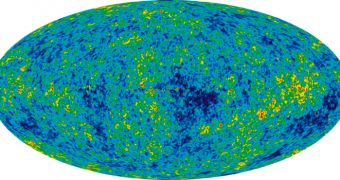Using the latest astronomical techniques and equipment, experts were recently able to map out the distribution of matter across the distant Universe, and found it to be more clumped up together than theories would have suggested. The work also provides more evidence that dark energy is real.
In order to gain a better understanding of this phenomenon, the investigators looked for distortions in the ancient light permeating the Universe, called the cosmic microwave background (CMB).
This is one of the few landmark studies that provide actual evidence that the stuff is real. The current Big Bang cosmological model calls for the existence of a force that pushes the Universe apart at ever-increasing speeds, while making up for more than 74 percent of its total mass and energy.
Astrophysicists call this dark energy. It contributes to clumping matter together into large-scale structures such as superclusters and galactic filaments, but its effects can only be inferred through tremendously complex measurements.
The international astronomical community is still debating whether dark matter and dark energy actually exist at all, given the lack of evidence to support these claims. The new study might help tip the scales a bit, but the debate is most likely very far away from being settled.
Details of the investigation appear in two papers published in the July 5 issue of the esteemed scientific journal Physical Review Letters. The work was conducted using the Atacama Cosmology Telescope in the Chilean Andes, Science News reports.
This investigation “will be a really powerful probe for figuring out dark energy and a lot of other interesting things,” explains Princeton University astronomy graduate student Blake Sherwin.
The scientist was also a member of the research team that used the 6-meter telescope to survey a narrow strip of the celestial equator. The group focused its attention on temperature variations in the CMB, and produced an extremely-detailed dataset.
In the end, the team was able to produce a sensitive reading of how mass was distributed in the early Universe. “What’s nice about being able to detect lensing using just the [CMB] is that you don’t have to make an assumption about knowing where the dark matter already is,” Sudeep Das explains.
The expert, also a member of the research team, is a postdoctoral fellow at the University of California in Berkeley (UCB). This is “arguably the most important measurement in physics in the last couple of decades, so it’s definitely worth confirming,” Sherwin adds.

 14 DAY TRIAL //
14 DAY TRIAL //